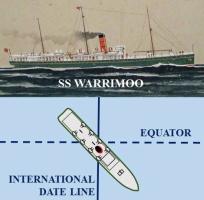 Here is a repost of wonderful sea story suitable for New Year’s Day. It also appears to be more or less true. RMS Warrimoo was an Australian/New Zealand passenger ship, launched in 1892. The ship is best remembered for crossing the intersection of the international dateline and the equator at precisely the turn of the century from 1899 to 1900. Here is how the story is usually told:
Here is a repost of wonderful sea story suitable for New Year’s Day. It also appears to be more or less true. RMS Warrimoo was an Australian/New Zealand passenger ship, launched in 1892. The ship is best remembered for crossing the intersection of the international dateline and the equator at precisely the turn of the century from 1899 to 1900. Here is how the story is usually told:
The passenger steamer SS Warrimoo was quietly knifing its way through the waters of the mid-Pacific on its way from Vancouver to Australia. The navigator had just finished working out a star fix and brought the master, Captain John Phillips, the result. The Warrimoo’s position was latitude 0 degrees x 31 minutes north and longitude 179 degrees x 30 minutes west.
The date was 30 December 1899. Know what this means? First Mate Payton broke in, we’re only a few miles from the intersection of the Equator and the International Date Line.
Captain Phillips was prankish enough to take full advantage of the opportunity to achieve the navigational freak of a lifetime. He called his navigators to the bridge to check and double-check the ship’s position. He changed course slightly to bear directly on his mark. Then he adjusted the engine speed. The calm weather and clear night worked in his favor. At midnight the Warrimoo lay on the Equator at exactly the point where it crossed the International Date Line!
The consequences of this bizarre position were many. The forward part of the ship was in the Southern Hemisphere and the middle of summer. The stern was in the Northern Hemisphere and in the middle of winter. The date in the aft part of the ship was 31 December 1899. Forward it was 1 January 1900.
This ship was therefore not only in two different days, two different months, two different seasons, and two different years but in two different centuries — all at the same time.
This is a great sea story, but did it happen? It looks like it may have, or, at least, came close to happening.
According to the Company of Master Mariners of Australia website, Captain J (John) D. S. Phillips was Master of 3326 tons R.M.S. WARRIMOO of the Canadian – Australian Lines in at least 1899 and 1900; he is listed as Master when the (Sydney) Evening News of October 17, 1900, reported RMS WARRIMOO as arriving Sydney on October 16 1900 from Vancouver via Honolulu and Brisbane with 32 passengers on board (all named except 3 children, a maid and 3 steerage passengers). She was also reported at Brisbane on April 28 and July 23, 1900, but the Master was not named on those occasions.
So, it appears that RMS Warrimoo was in the right ocean at more or less about the right time.
The only aspect of the story that is odd is the initial date and coordinates given on most versions of the story, which is December 30, and roughly 30 minutes of latitude and longitude from the intersection of the equator and the dateline. That put the ship slightly over 40 nautical miles away from the critical crossing point.
Based on the fact that the position was taken based on a starsight, that would make the time in the early evening, the day before New Year’s Eve. So, with a speed of around 14.5 knots, the ship would arrive at the crossing almost a day early.
On the other hand, if the date was really the 31st and not the 30th, the ship would have arrived either on time or late, depending on how long it took the Mate to reduce his star sights and so on.
The other wrinkle is that even if everything happened exactly as described, the accuracy of celestial navigation using a sextant and a chronometer is at best a mile, and in practice is often two or three miles, so there is a good chance that the 347′ long ship was a few thousand feet off, all other things being equal.
Regardless of what literally occurred the story about the RMS Warrimoo on the equator and dateline on exactly midnight 1900 is a wonderful sea story, worth retelling.
Happy New Year to all, wherever you may be on the briny globe.
Thanks to Miro for contributing to this post.
